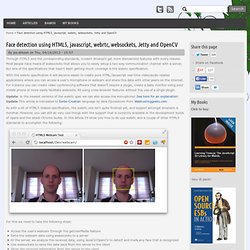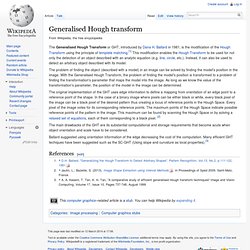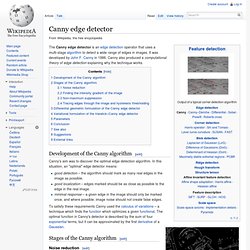

Face detection using HTML5, javascript, webrtc, websockets, Jetty and OpenCV. Through HTML5 and the corresponding standards, modern browsers get more standarized features with every release.

Most people have heard of websockets that allows you to easily setup a two way communication channel with a server, but one of the specifications that hasn't been getting much coverage is the webrtc specificiation. With the webrtc specification it will become easier to create pure HTML/Javascript real-time video/audio related applications where you can access a user's microphone or webcam and share this data with other peers on the internet.
For instance you can create video conferencing software that doesn't require a plugin, create a baby monitor using your mobile phone or more easily facilitate webcasts. All using cross-browser features without the use of a single plugin. Update: in the newest versions of the webrtc spec we can also access the microphone! For this we need to take the following steps: Which tools and technologies do we use What do we use at the backend: Www.vision.ee.ethz.ch/~surf/eccv06.pdf. Www.willowgarage.com/sites/default/files/orb_final.pdf. Www.cs.ubc.ca/~lowe/papers/ijcv04.pdf. Generalised Hough transform. The problem of finding the object (described with a model) in an image can be solved by finding the model's position in the image.

With the Generalised Hough Transform, the problem of finding the model's position is transformed to a problem of finding the transformation's parameter that maps the model into the image. As long as we know the value of the transformation's parameter, the position of the model in the image can be determined. The original implementation of the GHT uses edge information to define a mapping from orientation of an edge point to a reference point of the shape. In the case of a binary image where pixels can be either black or white, every black pixel of the image can be a black pixel of the desired pattern thus creating a locus of reference points in the Hough Space.
Every pixel of the image votes for its corresponding reference points. Ballard suggested using orientation information of the edge decreasing the cost of the computation. Jump up ^ D.H. Java - Algorithm improvement for Coca-Cola can shape recognition. Canny edge detector. The Canny edge detector is an edge detection operator that uses a multi-stage algorithm to detect a wide range of edges in images.

It was developed by John F. Canny in 1986. Canny also produced a computational theory of edge detection explaining why the technique works. Development of the Canny algorithm[edit] Canny's aim was to discover the optimal edge detection algorithm. Good detection – the algorithm should mark as many real edges in the image as possible.good localization – edges marked should be as close as possible to the edge in the real image.minimal response – a given edge in the image should only be marked once, and where possible, image noise should not create false edges. Stages of the Canny algorithm[edit] Noise reduction[edit] The image after a 5x5 Gaussian mask has been passed across each pixel.
Here is an example of a 5x5 Gaussian filter, used to create the image to the right, with = 1.4. Finding the intensity gradient of the image[edit] Non-maximum suppression[edit] Machine Learning/AI/Etc | Tech Topics.